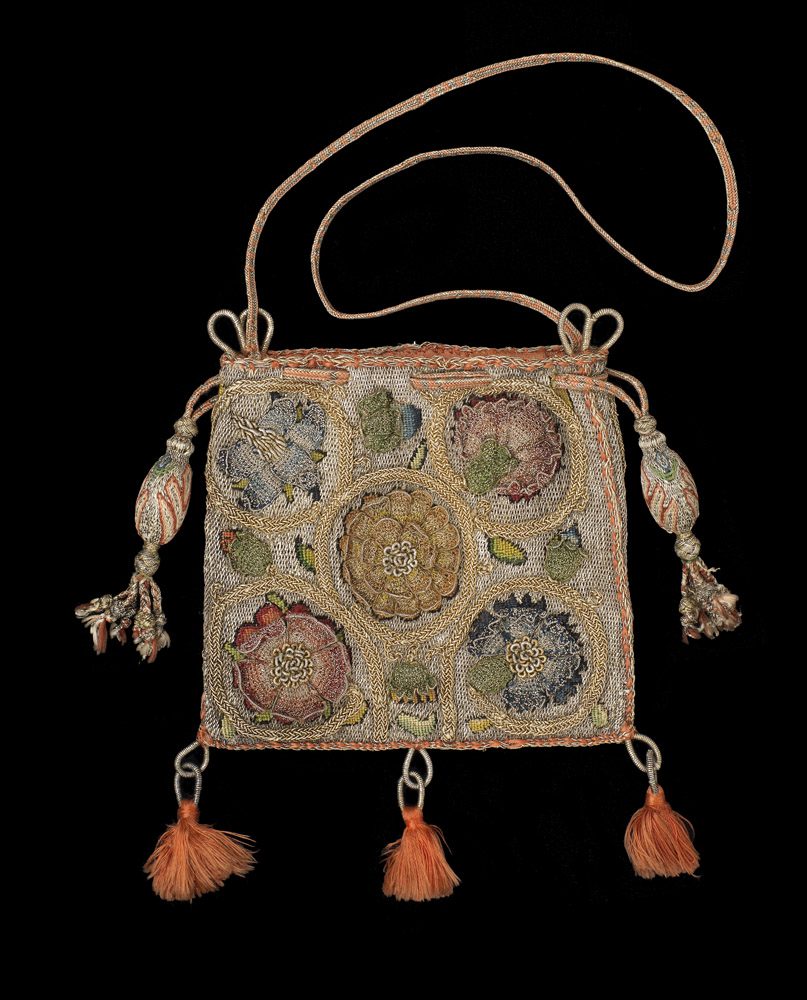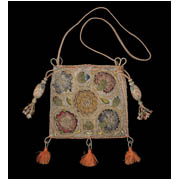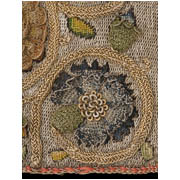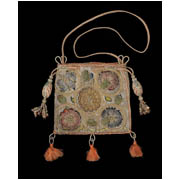Details
- Object type
bag; sweet bag
- Place Associated
England (place of manufacture)
- Date
circa 1600-1630
- Materials
silk, linen, metal
- Dimensions
overall: 330 mm x 170 mm x 10 mm
- Description
-
Woman's bag or sweet bag in linen embroidered with light blue, blue, dark blue, light green, green, dark green, light pink, pink, red and yellow silk, silver and silver-gilt threads worked in detached buttonhole, tent and brick stitch with purl in a rinceau pattern with a cinquefoil coiled stem enclosing five flowers, including a carnation, borage, cornflower and rose. Flowers worked in detached buttonhole stitch with some petals shaded by combining silk and metal threads, small leaves orked in tent stitch, background in brick stitch. Top edge with a drawstring of plaited pink silk and silver-wrapped threads decorated at the ends with tassels. Three red silk loops wrapped with metal purl with red silk tassels bottom left, centre and right. Lined with pink silk.
Small decorative bags or purses appear on many household inventories from the late 1500s and early 1600s often listed as ‘sweet bags’. The inventory taken after the death of Henry Howard (1540–1614), 1st Earl of Northampton, lists the contents of each room together with their monetary value, with several sweet bags listed in the higher library. Another inventory taken at Denmark House after the death of Anne of Denmark (1574–1619) includes a large number of sweet bags. The main use for these bags was to be filled with fragrant herbs or perfumed powders. These were placed in linen and clothes’ closets much like lavender bags today. K Platt, Delightes for Ladies, to adorn their Persons, Tables, Closets, and distillatories, 1602, includes an example of a typical recipe, whilst Gervaise Markham, Country Contentments, or The English Huswife, 1615, has instructions for a more complex fragrance. Another option was to wear such bags on the person suspended from a girdle around the waist. Several sweet bags have survived with pin cushions attached, which would have been hung together with other small items such as needlework tools and small books on or in same manner as a chatelaine, a clasp worn suspended from a woman’s waist with useful tools attached.
Small decorative purses were also used to hold money or jewellery given or presented on important occasions, such as those given to the monarch by bishops and the higher levels of the aristocracy at New Year. Henry Hastings (1586–1643), 5th Earl of Huntingdon, described making his gift in 1604–5; 'The manner of presenting a New Year’s gift to his Majesty from the Earl of Huntingdon. You must buy a new purse of about Vs. price, and put thereinto 20 pieces of new gold of 20s. apiece, and go to the Presence-Chamber, where the Court is, upon New Year’s day, in the morning about 8 o’clock, and deliver the purse and the gold unto my Lord Chamberlain…'.
This sweet bag is very similar to examples in the British Museum, London, the McCormick Collection at the Museum of Fine Arts, Boston, and in the Victoria & Albert Museum, London. This suggests that these bags were created ready to be purchased for such occasions as the New Year’s gifts. The lavish style of embroidery on all of these with their ground of brick stitch is also found on the Devereux bodice that is thought to have belonged to Frances Walsingham (1567–1633), Countess of Essex and Clanricarde, wife of Robert Devereaux (1565–1601), 2nd Earl of Essex, that is now in the Kyoto Costume Institute, Tokyo.
Provenance: Bernheimer Fine Arts Limited; from where purchased by the Burrell Trustees in 1991.
- Credit Line/Donor
Purchased by the Burrell Trustees, 1991
- Collection
Burrell Collection: British Embroideries
- ID Number
29.310
- Location
In storage





